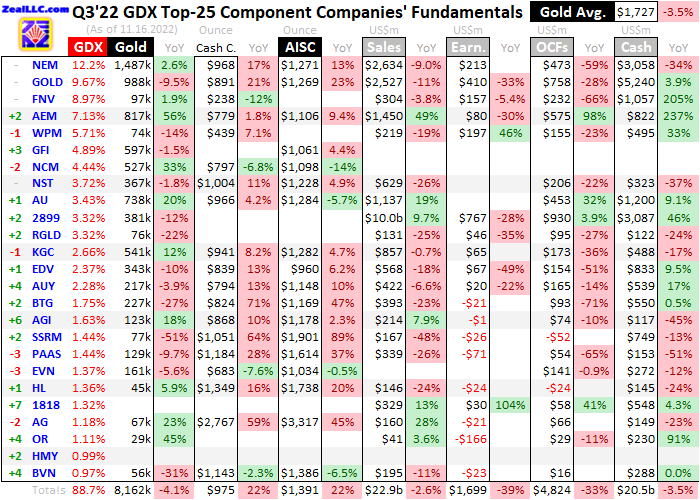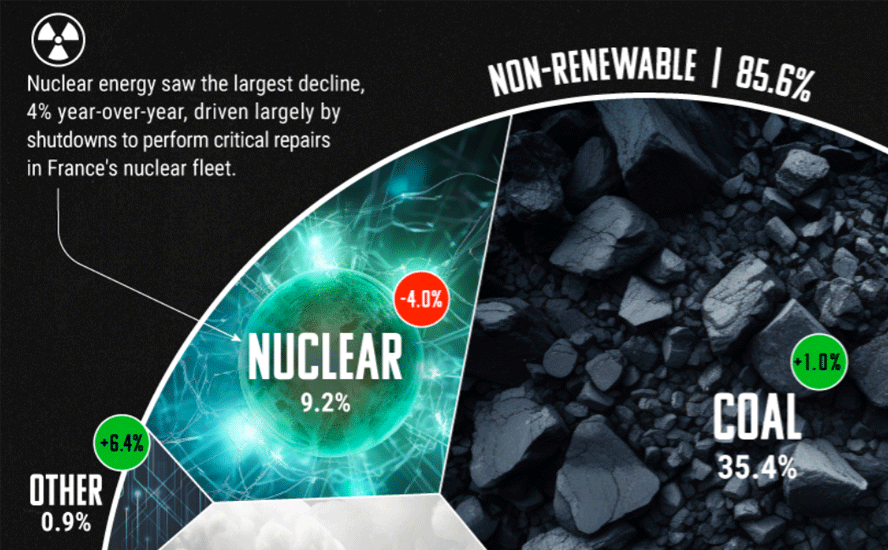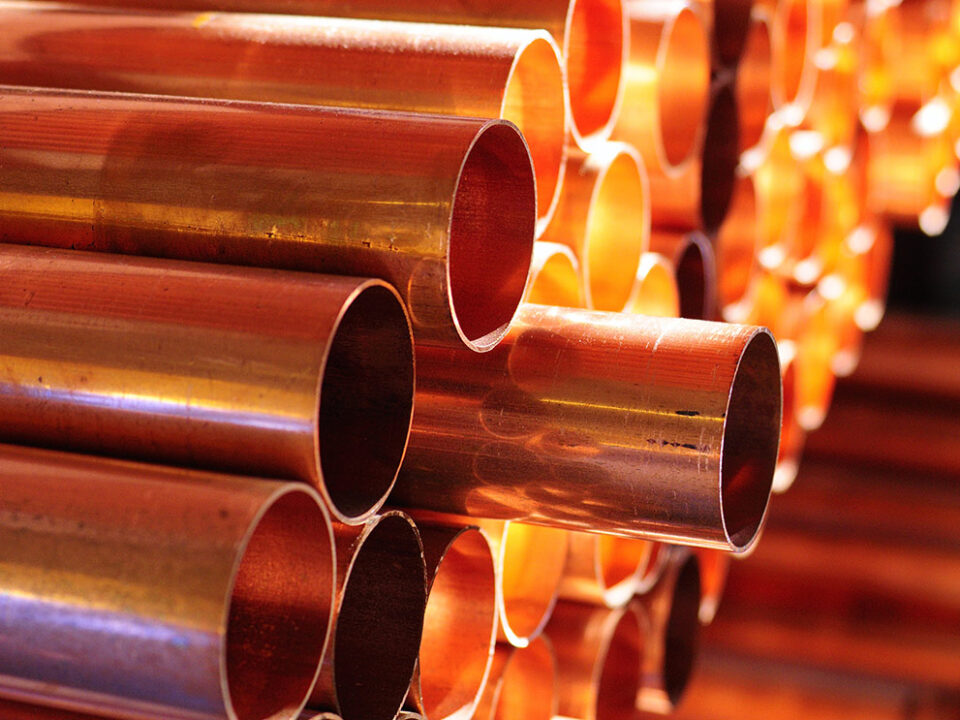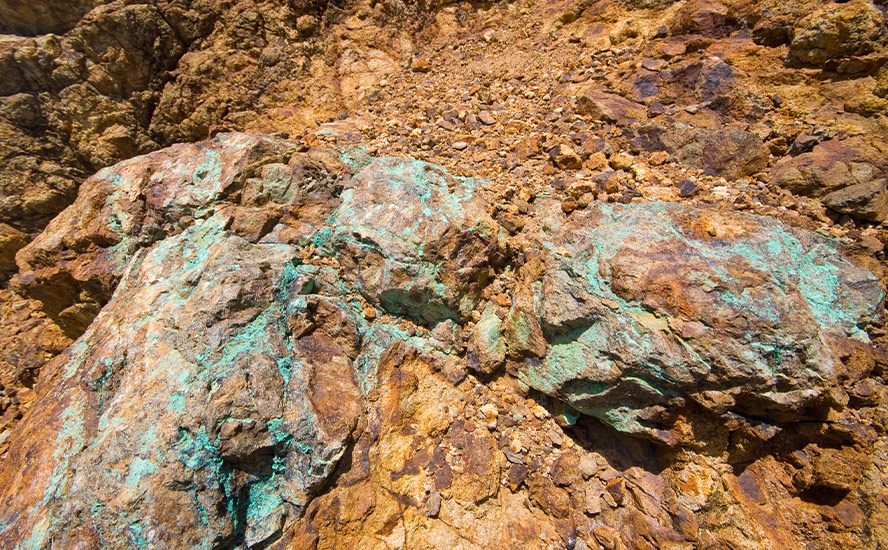Gold Miners’ Q3’22 Fundamentals
By Adam Hamilton
2022.11.18
The battered major gold miners’ stocks rocketed higher with their metal in recent weeks, showing signs of life. That vertical breakout started to rekindle traders’ interest in this left-for-dead contrarian sector. Gold stocks’ upside potential in coming months partially depends on how these companies are actually faring fundamentally. Their latest quarterly results from the just-wrapping-up Q3’22 earnings season illuminate that.
The major gold stocks have had a roller-coaster ride of a year, as evident in their leading and dominant sector benchmark. That remains the venerable GDX VanEck Gold Miners ETF. Launched in May 2006, GDX’s first-mover advantage has grown it into a juggernaut. Its net assets of $11.4b this week dwarfed those of the next-largest 1x-long gold-miners-ETF competitor by a huge 29.7x! GDX is the only game in town.
The larger gold miners responsible for most of this ETF’s weighting tend to amplify material gold moves by 2x to 3x. Between late January to mid-April, GDX soared 39.5% far outperforming a parallel 10.4% gold surge. But those nascent uplegs in both gold and its miners’ stocks were suddenly derailed by the US dollar rocketing parabolic on the most-extreme tightening the Fed has ever attempted! It was a bloodbath.
From mid-April to late September, GDX cratered an exceedingly-painful 46.5% on gold plunging 17.9%! That scared everyone but the most-hardcore contrarians out of this sector. Gold was slammed lower by heavy-to-extreme gold-futures selling as the US Dollar Index soared 13.2% in that same span. Gold’s dismal reaction was even more frustrating with inflation raging out of control, which is historically fantastic for gold.
GDX leveraged that anomalous dollar-driven gold drop by a normal 2.6x, but that slaughtered sentiment so traders abandoned this sector. Since those brutal wildly-oversold and radically-undervalued lows, the gold stocks have started recovering sharply. As of last Friday, GDX had soared 29.4% at best on gold mean reverting 8.9% higher! The USDX collapsed 6.7% on Fed-dovish surprises from key economic data.
That started with the latest US monthly jobs report released in early November, which suffered multiple internal metrics deteriorating. That lowered futures-implied Fed-rate-hike odds, clobbering the US dollar. So gold-futures speculators flocked back, catapulting gold 8.4% higher over the next six trading days. GDX skyrocketed 24.8% in that same short span, amplifying gold 2.9x. Do fundamentals support more upside?
For 26 quarters in a row now, I’ve painstakingly analyzed the latest results released by GDX’s 25-largest component stocks. These include the world’s biggest gold miners, which now account for a commanding 88.7% of this ETF’s entire weighting. Digesting hard fundamental results as they are released is essential for cutting through obscuring sentiment fogs. It helps traders rationally understand gold stocks’ real outlook.
This table summarizes the operational and financial highlights from the GDX top 25 during Q3’22. These gold miners’ stock symbols aren’t all US listings, and are preceded by their rankings changes within GDX over this past year. The shuffling in their ETF weightings reflects shifting market caps, which reveal both outperformers and underperformers since Q3’21. Those symbols are followed by their current GDX weightings.
Next comes these gold miners’ Q3’22 production in ounces, along with their year-over-year changes from the comparable Q3’21. Output is the lifeblood of this industry, with investors generally prizing production growth above everything else. After are the costs of wresting that gold from the bowels of the earth in per-ounce terms, both cash costs and all-in sustaining costs. The latter help illuminate miners’ profitability.
That’s followed by a bunch of hard accounting data reported to securities regulators, quarterly revenues, earnings, operating cash flows, and resulting cash treasuries. Blank data fields mean companies hadn’t disclosed that particular data as of the middle of this week. The annual changes aren’t included if they would be misleading, like comparing negative numbers or data shifting from positive to negative or vice-versa.
Unfortunately the GDX major gold miners collectively reported a weaker quarter in Q3, with most facing mounting inflationary cost pressures cutting into their profitability. These elite gold stocks are reporting their highest unit costs ever! And lower production combined with lower gold prices certainly didn’t help either. But while Q3’22 was disappointing, big gold-stock upside potential remains as gold mean reverts higher.

The world’s bigger gold miners have always struggled with production growth. They operate at such huge scales that it’s almost impossible to replenish their gold mined. They simply can’t discover or buy enough gold deposits at necessary sizes to overcome relentless depletion. And they can’t develop the ones they do find or acquire into new mines rapidly enough. So major gold miners have long suffered shrinking output.
Q3’22 offered no respite from this vexing trend, with the GDX top 25’s aggregate gold production falling 4.1% YoY to 8,162k ounces. That was despite some sizable mergers combining major gold miners and making way for more to climb into these rarefied ranks. Over this past year, Agnico Eagle Mines bought out the wonderful Kirkland Lake Gold while Australia’s mighty Newcrest Mining acquired Pretium Resources.
Bigger gold-stock mergers have always been problematic for investors. Larger miners struggling with shrinking production buy out smaller ones with far-superior fundamentals and upside. Acquirees’ great gold mines are absorbed and diluted by acquirers’ average ones, leaving the combined entities’ stocks much-lower upside potential. And that new production bought only masks ongoing depletion for a single year.
Agnico Eagle is a great example of this, with gold output rocketing up a GDX-top-25-leading 56.0% YoY last quarter! But that’s only because it bought out a smaller and way-better rival. Compared to those two separate companies’ production in Q3’21, this new merged miner actually produced 8.6% less gold in Q3’22! And Kirkland Lake’s wildly-profitable $740 all-in sustaining costs vanished into AEM’s $1,106 ones.
The major gold miners’ endless production-growth struggles are even more apparent when illuminated by overall gold-mining trends. The best-available global gold supply-and-demand data is published once a quarter by the World Gold Council, in its fantastic Gold Demand Trends reports. The latest covering last quarter was just released earlier this month. It revealed world gold mine output climbing a strong 2.3% YoY.
So the biggest-and-best gold miners dominating GDX are really underperforming their smaller peers with that 4.1% YoY shrinkage. Even more damning, the GDX top 25’s collective gold mined in Q3’22 plunged 3.9% sequentially from Q2’22! The WGC’s data has long revealed that Q3s are the strongest quarters by far for production growth. Total world output actually surged a strong 6.5% quarter-on-quarter in Q3’22.
That’s actually not unusual at all. During the decade ending 2021, on average Q1s, Q2s, Q3s, and Q4s saw sequential QoQ world gold production running -8.5%, +4.1%, +7.0%, and +0.7%! If the major gold miners can’t even grow their collective output in these strong Q3s, they are seriously failing to overcome their own depletion. This quarterly seasonality in global gold-mining output is explained by several things.
As new years dawn, mine managers get new budgets to maintain and upgrade gold-mine infrastructure. A disproportional amount of that work is done in Q1s, temporarily slowing or stopping production. Q1s also see peak winter months in the northern hemisphere where most of the world’s gold mines are found. The cold temperatures slow the chemical processes used in heap leaching to recover gold from crushed ores.
Conversely Q3s have the warmest months on the top half of the planet, speeding up gold recoveries. By that time of the year any maintenance and light expansion work is usually done, allowing production to run uninterrupted. And mine managers often choose to sequence higher-grade ores during Q3s, boosting their outputs. That’s because Q3 results are the last-reported ones before year-end bonuses are calculated.
Higher gold-stock prices heading into year-ends often increase compensation for mine managers, so they game ore grades accordingly. If they have to dig through lower-grade ores, they try to schedule them for first halves of years so better grades are available in second halves. Whatever the reasons, gold miners’ production usually swells considerably in Q3s. That 7.0% Q2-to-Q3 average growth since 2012 is massive.
Since investment capital tends to migrate to gold miners with superior growth, there’s no doubt the elite GDX top 25 would grow their outputs if they could. But their aggregate production has generally been grinding lower since Q4’16, when it peaked at 9,525k ounces. That’s one key reason smaller mid-tier and junior gold miners generally have better fundamentals. It’s easier to grow output at their lesser operating scales.
With both lower production and mounting mining costs fueled by raging inflation, the GDX top 25’s costs wouldn’t be pretty. In normal times, unit gold-mining costs are generally inversely-proportional to gold-production levels. That’s because gold mines’ total operating costs are largely fixed during pre-construction planning stages, when designed throughputs are determined for plants processing gold-bearing ores.
Their nameplate capacities don’t change quarter to quarter, requiring similar levels of infrastructure, equipment, and employees to keep running at full-speed. So the only real variable driving quarterly gold production is the ore grades fed into these plants. Those vary widely even within individual gold deposits. Richer ores yield more ounces to spread mining’s big fixed costs across, lowering unit costs and boosting profitability.
But while fixed costs are the lion’s share of gold mining, there are also sizable variable costs. Energy is the biggest category, including electricity to power ore-processing plants including mills and diesel fuel to run excavators and dump trucks hauling raw ores to those facilities. Other smaller consumables range from explosives to blast out ores to chemical reagents necessary to process various ores to recover their gold.
Most of the major gold miners’ Q3’22 quarterly reports blamed inflation for their higher mining costs. The world’s biggest gold miner Newmont warned of “higher direct operating costs as a result of inflationary pressures, driven by higher labor costs and an increase in commodity input costs, including higher fuel and energy costs.” The second-largest gold miner Barrick Gold echoed Newmont in explaining higher costs.
Barrick’s quarterly warned of “higher site operating costs from higher input prices driven by energy, labor and consumables due to inflationary pressures.” The third-largest gold miner Agnico Eagle reported the same, “inflation on production costs was largely driven by higher input prices in key consumables (such as energy, cyanide and steel), which have experienced increases above the 5% to 7% general inflation rate”.
Cash costs are the classic measure of gold-mining costs, including all cash expenses necessary to mine each ounce of gold. But they are misleading as a true cost measure, excluding the big capital needed to explore for gold deposits and build mines. So cash costs are best viewed as survivability acid-test levels for the major gold miners. They illuminate the minimum gold prices necessary to keep the mines running.
Last quarter the GDX top 25’s average cash costs rocketed up 22.4% YoY to a record $975 per ounce! That was pretty shocking, as before Q1’20 these elite gold miners’ broader all-in sustaining costs had never been higher than $925. While the great majority of miners suffered surging costs, this lofty average cash cost was skewed by a couple anomalous extreme outliers. They are SSR Mining and First Majestic Silver.
SSRM suffered a horrendous Q3, seeing its total gold production crash 51.5% YoY which was far worse than any of its peers! That was because operations were temporarily suspended at its primary gold mine in Turkey. In late June, a small cyanide leak was discovered from a pipe running to its leach pad. That was quickly cleaned and fixed, but local regulators didn’t authorize mining to resume until late September.
That mine being offline for a quarter catapulted SSR Mining’s cash costs up 64.5% YoY to $1,051. They will collapse back to inflation-adjusted norms in coming quarters with that mine running. Even worse were First Majestic Silver’s insane $2,767 cash costs which soared 59.5% YoY! This company operates three primary silver mines that are thriving, and a fourth small gold one yielding under a quarter of AG’s gold in Q3.
That problematic mine has been plagued with sky-high costs ever since AG bought it, and they continue to worsen despite guidance to the contrary. The three-fourths of First Majestic’s gold production coming from its silver mines is considered a byproduct, so reported cash costs are only for that little gold mine’s 16k ounces in Q3. That rounding error of a sliver of GDX-top-25 output shouldn’t unduly taint the whole.
So excluding SSRM’s temporarily-high cash costs and AG’s problematic little gold mine, the rest of the GDX top 25 averaged a much-healthier $865 per ounce. While still high, that would only be up 8.6% YoY. That’s quite impressive given the major gold miners’ lower output to spread mining costs across and this raging inflation. And those cash costs remain far below Q3’22’s average gold price of $1,727.
All-in sustaining costs are far superior than cash costs, and were introduced by the World Gold Council in June 2013. They add on to cash costs everything else that is necessary to maintain and replenish gold-mining operations at current output tempos. AISCs give a much-better understanding of what it really costs to maintain gold mines as ongoing concerns, and reveal the major gold miners’ true operating profitability.
Last quarter’s GDX-top-25 AISCs looked much like cash costs, rocketing up a colossal 21.9% YoY to hit a lofty record $1,391! But again those were heavily distorted by the extremes reported by SSRM and AG, which were $1,901 and a jaw-dropping $3,317. Pull those two outliers, and the rest of the major gold stocks averaged a far-better $1,239. That also just climbed 8.5% YoY, despite lower output and surging input costs.
With production down that 4.1% YoY, that should have driven unit costs a proportional 4%ish higher. And an additional 4% to 5% on top of that reflecting inflation-bloated variable costs is reasonable, showing the major gold miners are trying to hold the line. Still even these adjusted AISCs clocked in at the second highest ever after the prior quarter’s $1,281. And two other outliers required that too to be adjusted down to $1,161.
The problem with high all-in sustaining costs is they cut into profit margins. Considering the gold carnage this year on that parabolic US dollar spike, gold actually fared pretty well last quarter. It averaged $1,727 in Q3’22, which was merely down 3.5% YoY. Subtracting average AISCs from prevailing gold levels is a great proxy for sector unit profitability. Unfortunately that utterly collapsed with gold slipping as costs soared.
The GDX top 25’s implied unit profits cratered 48.2% YoY to just $335 per ounce, the worst seen in this entire research thread since way back in Q2’16! But again that $1,391 AISC average wasn’t righteous. Two miners with under 144k ounces of quarterly gold output were unduly distorting the other major gold miners’ vastly larger 8,018k production. Again excluding those SSRM and AG anomalies, AISCs ran $1,239.
That implies much-better unit profits of $487 per ounce last quarter. While still down 24.7% YoY and the worst since Q2’19, those sure aren’t great. But the major gold miners continue to earn healthy profits even in these challenging times. Those should really improve in coming quarters as gold mean reverts higher. Interestingly the GDX top 25 expect lower AISCs too, as their full-year-2022 guidances average $1,215.
These elite gold miners’ hard accounting data reported to securities regulators under Generally Accepted Accounting Principles or other countries’ equivalents also reflected Q3’22’s challenges. The GDX top 25’s total revenues actually proved resilient, only slumping 2.6% YoY to $22,892m last quarter. With that quarterly-average gold price being 3.5% lower and output down 4.1%, sales should’ve retreated 7% to 8%.
But gold miners’ quarterly gold sales often don’t match underlying production. Some gold produced in a given quarter isn’t fully processed until the following quarter. And occasionally managements choose to hold on to recovered ounces to sell in future quarters, usually in response to an oversold gold price. Production and especially market prices of byproduct metals can really vary too, impacting top-line revenues.
The GDX top 25’s bottom-line accounting profits certainly reflected their higher mining costs, plunging by 39.5% YoY to $1,699m! That’s definitely weak, the lowest since Q2’19. The previous ten quarters saw total earnings average $2,898m. To return near more-normal levels, the major gold miners either have to lower their rising AISCs or see better gold prices. Both are likely in coming quarters, really boosting profits.
The major gold miners’ cash flows generated from operations fell a similar 33.0% YoY to $4,824m. That is actually just a two-quarter low, not too bad given these inflationary times. Those OCFs helped keep the GDX top 25’s collective treasuries full, with their total cash only slipping 3.5% YoY to $20,464m. That will be used for accelerating mine expansions and buying other companies’ mines outright to help offset depletion.
That makes the smaller mid-tier and junior gold miners prime targets for majors to acquire! These smaller gold miners have superior fundamentals and much-greater upside potential than the majors. Operating at smaller scales they can more easily consistently grow their production, while their lower market caps make them easier to bid higher. They also have lower-cost mines which the major miners desperately need.
The bottom line is the major gold miners just reported a weaker quarter. Their collective production fell despite overall global mined gold output rising, as they continue to struggle with depletion. Less gold mined boosted unit costs proportionally, which were further exacerbated by inflationary pressures on input costs. That along with lower average gold prices slashed earnings to their lowest levels in several years.
Nevertheless the major gold miners still continued to generate solid profits and operating cash flows. They are forecasting lower all-in sustaining costs in coming quarters, which will boost earnings. And gold itself is overdue to mean revert way higher with that extreme US dollar parabola collapsing. So gold miners’ fundamentals should really improve, supporting much higher gold-stock prices as gold powers higher.
Adam Hamilton, CPA
Legal Notice / Disclaimer
Ahead of the Herd newsletter, aheadoftheherd.com, hereafter known as AOTH.Please read the entire Disclaimer carefully before you use this website or read the newsletter. If you do not agree to all the AOTH/Richard Mills Disclaimer, do not access/read this website/newsletter/article, or any of its pages. By reading/using this AOTH/Richard Mills website/newsletter/article, and whether you actually read this Disclaimer, you are deemed to have accepted it.



























